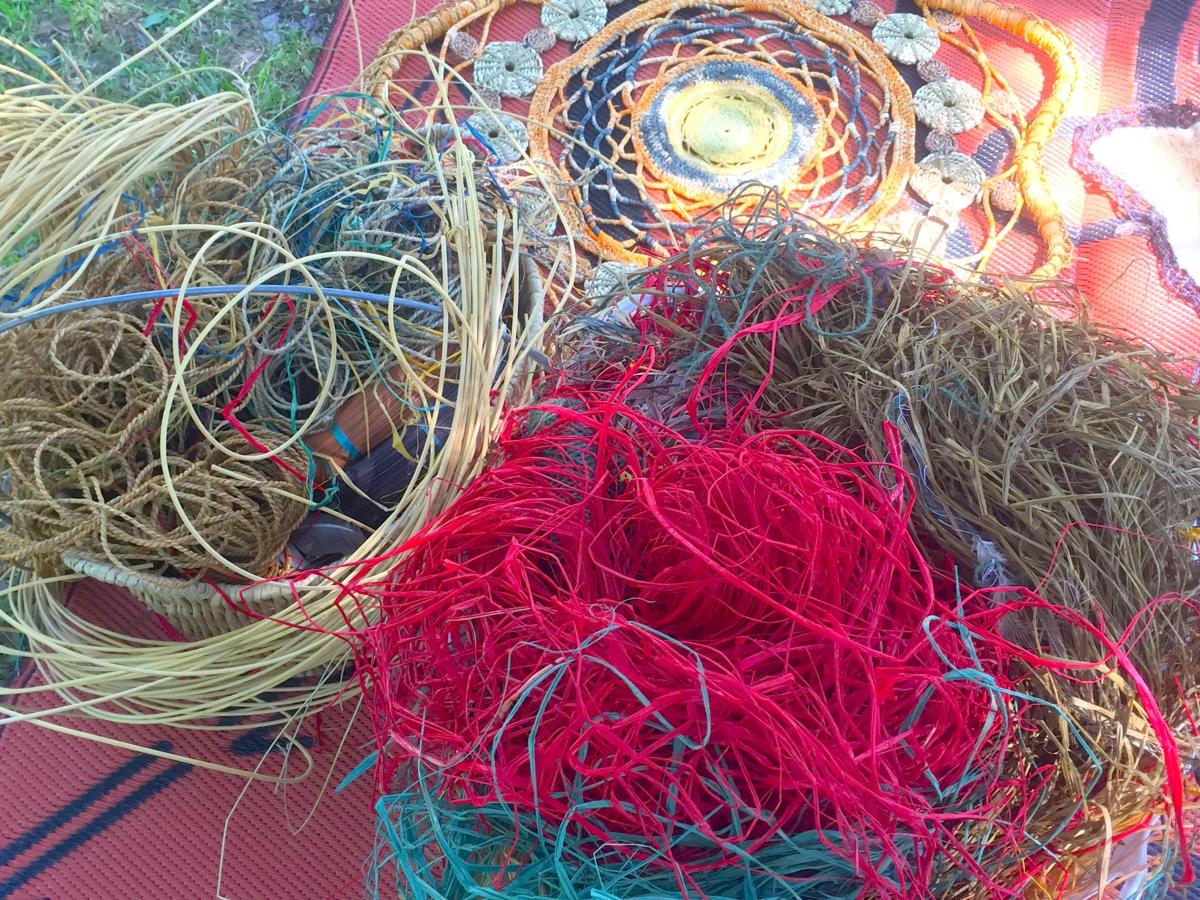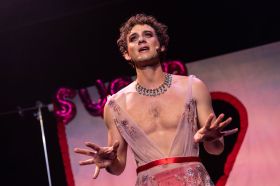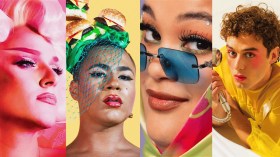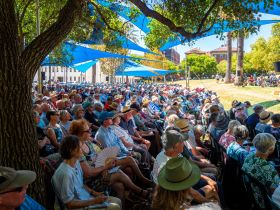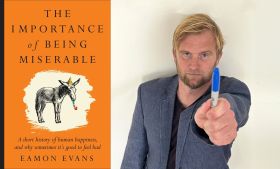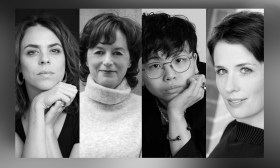Two key moments in last week’s Artlands conference in Dubbo bookended the four days of discussions with a powerful new pathway for the integration of Indigenous culture in the arts sector.
Sydney Festival Director Wesley Enoch, an Indigenous arts leader, summarised the impact of the discussion when he said, ‘We constantly talk about funding but what we need, in fact, is less of that and more philosophy and ideas. The ideas this conference has raised has talked about First Nations in a way that no other conference in this country has talked about before.’
It underscored a foundation that was set by Waradjuri man Mark McMillan, Associate Professor at Melbourne University Law School, who in his opening keynote reframed the discussion between white and Aboriginal Australia as a discussion of how sovereignty can be shared in a two- way relationship.
‘How can non-Indigenous people locate their own sovereignty so it can be in relation to ours, not as trying to control it, not as trying to own it, not as trying to deny it – but in relation to it?’ McMillan asked.
We close the gap by you coming our end and learning and embedding in our culture because it is the heart of our nation.
What set the Artlands conversation apart was an emphasis on the value of what Indigenous culture has to offer rather than on the problems faced by the Indigenous sector.
As Enoch said, ‘We think of closing the gap and deficiencies; we don’t think about what First Nations have to teach the rest of the country. The more we connect with the landscape, and the less we think of being on top of it, the more we will grow.’
Read: Presenters reject Indigenous art
Lindy Hume, Artistic Director Opera Queensland said the challenge was how to make First People’s culture and art be ‘central to what we all do’.
‘We have talked about it for years but now we are being challenged what to do about it and to think how in our own practice and ask what collaboration and partnerships really mean for us all of us to put the culture of First Nations People at the core of our business.’
Read: What you can do to improve Indigenous representation
Indigenous Tasmanian poet and playwright Jim Everett said white Australia still did not understand the underpinnings of Indigenous culture
‘The most important and extreme difference we have is that our philosophy is diametrically opposite to western philosophy, and to understand us you need to understand Aboriginal philosophy. White Australia hasn’t got a grip on it,’ Everett explained.
Come our end
In his discussion of shared sovereignty, McMillan offered the kind of chewy mind-flip that we hanker for from a conference, delivering a dense paper that landed in a swirl of concepts. It became an anchor for new thinking across Artlands and beyond.
He said the question we need to be asking is, ‘What do I need to do as a non-Indigenous person so that I can participate in the relationship? Tell me what to do so I can be in this with you.’ While sovereignty might sound like a big picture issue that belongs to governments and constitutions, McMillan said it is actually too personal to just hand to the State.
Instead we have to think about our personal value systems and how they can be adjusted to make room for others.
‘Indigenous nation building is not a new concept. We are not trying to transplant it, not trying to own it or confuse it, but trying to share it.
‘How do we start to imagine a space when non-Indigenous and Indigenous people start to let go of their preconditioned value systems and their demands in how it can be done?’ said McMillan.
Similarly, Rhoda Roberts, Indigenous program curator for Sydney Opera House, told the panel discussion Exploring different cultural authorities in creating new and innovative understandings that we need to rethink what equality looks like.
‘Don’t talk to me about closing the gap! You want me to be more educated, to buy a house and have a nice car, so I learn to speak the dominant society – we’ve got all that. We close the gap by you coming our end and learning and embedding in our culture because it is the heart of our nation,’ said Roberts.
She added: ‘We are too busy on Twitter and Facebook to listen to country.’
Lee-Anee Buckskin also touched on the topic, quoting Noel Pearson’s Quarterly essay: ‘It is in the importance of respecting memory, tradition, richness and values as preconditions of change and innovation that we risk a smaller sense of nation, a smaller sense of our own possibilities – we don’t place our culture at the centre of what we do.’
Buckskin said: ‘There was no use of being angry – I could – but I believed in my own capability and used that energy to do something good. It is not about me; it is about my people. What we are talking about is innovation and capability – we have been doing that for 75,000 years, it is part of our ancestral code.’
More than just words; it’s about language
We have been accustomed to the Welcome to Country – to singing visitors to country, or delegates to a conference or formal event. But at Artlands, Indigenous language was presented as a living force that was not just a symbol or token but something which needs to be integrated into everyday Australia
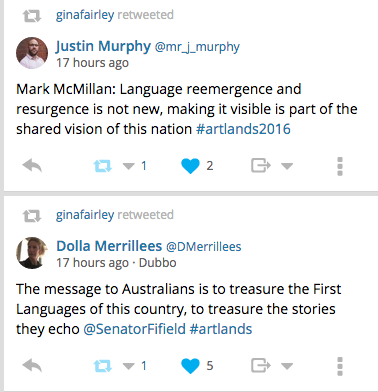
Buckskin said: ‘Language is central to our identity. We have 145 languages in this country; 110 of those are endangered.’
The everyday embrace of Indigenous languages was encapsulated in a new initiative announced by Federal Minister for Communication and the Arts, Mitch Fifield. The project, a partnership between First Languages Australia and the ABC, will provide station identification messages in Indigenous languages on radio stations across the country.
The 15-second station IDs are recorded in local Indigenous language by locals and will be rolled out this week to 48 locations across Australia.
‘The message to all Australians is to treasure the first languages of this country and the stories they echo and the stories that they continue to tell,’ said Fifield.
Read: This message is brought to you in a language you may not understand
Buckskin said that there was an ‘urgency’ to record and maintain language. ‘We want our parents to read to children in language.’
Many of us can say hello, goodbye and thank you in half a dozen European languages, but how many Australians can repeat the feat in even one Aboriginal language?
The more that we embrace these languages, the more we will form a sense of connection with living on country – because as White Australians we are also born on country – and then some of those barriers and preconceptions will start to break down.
As McMillan said: ‘Those languages that Senator Fifield talks about, these are not just something that will happen with the result of this extra funding. Language emergence and resurgence has been going on since the colonial project began. What is now making it more visible is when and how we can use it, who can use it, and how our languages are to be shared. It becomes the vision of the nation.
‘It is our languages that we must retake and relearn for our cultural purposes and we must understand what it is that we are doing with languages. How do we make these words that have been captured to have cultural resonance?’
With disruption comes opportunity, said Maori artist Karl Johnstone: ‘The challenge of recalibration is to remained focused as we move forward.’
Language may be one path, art and culture another.
Choreographer Ghenoa Gela and her dancers performing at Artlands 2016; Gela won the Keir Choreographic Award earlier this year.
The future lies in the confidence of our youth
The repeated sentiment across this conference was a fear or worry for young Aboriginal people. We have the highest rates of suicide in this country for our children, said Buckskin.
She spoke of her own vulnerability and the ability of art to liberate and elevate young people. ‘What I understood was the arts was a vehicle for change; art was a way we could express ourselves, and in those contemporary spaces we were able to practice our culture. Festivals are an incredible environment for that and an important environment too for our young people to come into that.’
She said that mentoring Aboriginal youth is not just about number and systems. ‘It needs to be holistically. By that I mean, “How is their health to be able to dance, to perform? How is their mental health?”
‘Young people need to see themselves in this country and we can not underestimate what arts and culture can do … art and culture, language identity – this is not an aesthetic thing, a painting on the wall – this is a way of being. We are honouring in the artistic space our ancestors through making. We need to respect the cultural heritage of this country and place it at the heart of everything we do.’
A glimpse of vitality
Walking away from Artlands 2016 I was abuzz. It was like a switch had finally been been flicked – I realised I was permitted to be part of this Aboriginal narrative of country, and had been welcomed into it.
And, through that reciprocity, a glimmer of a future appeared. To return to Wesley Enoch’s opening words ‘this was like no conference before’, and it was an overdue conversation.
To give readers a sense of the level of immersion of First Nations conversations within the Artlands 2016 conference, here are just some of the topics, talks, performance and exhibitions that were part of the program.
- Film and new media connecting rural and regional First Nations, national and internationally
- Magnifying First Nations voices through film
- Activating the conduit of lawful relationships between Indigenous and non-Indigenous people when viewing and engaging art and artifacts
- We are listening but are you hearing? Working with Aboriginal and culturally diverse communities
- Paper bark flower workshop
- Master fibre makers workshop and gathering
- Legacy from Kalgoorlie-Boulder, First Nations festival
- Presenting First Nations performing art
- Performance: This fella, my country
- Performance: Three Brothers
- Performance: Buried Country, a history of Aboriginal country music
- Performance: Radical Sun
- Dance: Medleko Meropa, roving performance throughout Artlands
- Dance: Winds of Woerr, choreographer Ghenoa Gela
- Exhibition curated by Djon Mundine, Old land new marks
- Walaggay Left Field Project 2, an exhibition of regional Indigenous artists curated by Khaled Sabsabi for Orana Arts
Artlands 2016 was held in Dubbo, regional NSW 27-30 October. In 2018 the next regional arts conference will be hosted by Victoria.

